| Revision as of 22:40, 13 February 2015 editColonies Chris (talk | contribs)Autopatrolled, Extended confirmed users, Pending changes reviewers, Rollbackers445,699 editsm minor fixes, replaced: , CT → , Connecticut (3), , NC → , North Carolina, , MN → , Minnesota, ,'' → '', , , WA → , Washington (2), 848 - 195 → 848–195 (3), oy Jr → oy, Jr., Jr.. → Jr., using AWB← Previous edit | Revision as of 23:44, 13 February 2015 edit undo75.130.122.206 (talk) →External linksNext edit → | ||
| Line 412: | Line 412: | ||
| ] | ] | ||
| ] | ] | ||
| ] | |||
| ] | ] | ||
| ] | ] | ||
Revision as of 23:44, 13 February 2015
For other uses, see Roy Rogers (disambiguation).| Roy Rogers | |
|---|---|
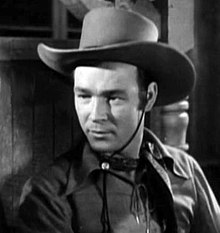 Rogers in The Carson City Kid, 1940 Rogers in The Carson City Kid, 1940 | |
| Born | Leonard Franklin Slye (1911-11-05)November 5, 1911 Cincinnati, Ohio, U.S. |
| Died | July 6, 1998(1998-07-06) (aged 86) Apple Valley, California, U.S. |
| Resting place | Sunset Hills Memorial Park, Apple Valley, California 34°33′25″N 117°08′35″W / 34.5569916°N 117.1429367°W / 34.5569916; -117.1429367 |
| Other names | King of the Cowboys, Len Slye |
| Occupation(s) | Singer, actor |
| Years active | 1935–1984 (acting) |
| Style | Western |
| Spouses |
|
| Website | royrogers |
| Origin | Inglewood, California |
| Genres | Country, Western |
| Instrument(s) | Vocals, guitar |
| Years active | 1932–1991 |
| Musical artist | |
Roy Rogers (born Leonard Franklin Slye November 5, 1911 – July 6, 1998) was an American singer and cowboy actor who was one of the most popular Western stars of his era. Known as the "King of the Cowboys", he appeared in over 100 films and numerous radio and television episodes of The Roy Rogers Show. In many of his films and television episodes, he appeared with his wife Dale Evans, his golden palomino Trigger, and his German Shepherd dog Bullet. His show ran on radio for nine years before moving to television from 1951 through 1957. His productions usually featured a sidekick, often Pat Brady, Andy Devine, or George "Gabby" Hayes. In his later years, Rogers lent his name to the Roy Rogers Restaurants franchised chain.
Biography
Early life
Rogers (Leonard Slye) was born to Mattie (née Womack) and Andrew "Andy" Slye in Cincinnati, Ohio. The family lived in a tenement building on 2nd Street, where Riverfront Stadium would later be constructed (Rogers would later joke that he was born at second base). Dissatisfied with his job and city life, Andy and his brother Will built a 12-by-50-foot (3.7 m × 15.2 m) houseboat from salvage lumber, and in July 1912 the Slye family traveled up the Ohio River towards Portsmouth, Ohio. Desiring a more stable existence in Portsmouth, they purchased land on which to build a house, but the Great Flood of 1913 allowed them to move the houseboat to their property and continue living in it on dry land.

In 1919 the Slye family purchased a farm in Duck Run, located near Lucasville, Ohio about 12 miles (19 km) north of Portsmouth, and built a six-room house. Andy Slye soon realized that the farm alone would provide insufficient income for his family, so he took a job at a Portsmouth shoe factory, living in Portsmouth during the week and returning home on weekends bearing gifts following paydays. A notable gift was a horse on which young Len Slye learned the basics of horsemanship. Living on the farm with no radio, the family made their own entertainment. On Saturday nights, the family often invited neighbors over for square dances, during which Len would sing, play mandolin, and call the square dances. He also learned to yodel during this time, and he and his mother would use yodeling calls to communicate with each other across distances on the farm.
After completing the eighth grade, Len attended high school in McDermott, Ohio. After completing his second year in high school, his family returned to Cincinnati, where his father began work at another shoe factory. Realizing that his family needed his financial help, Len quit school and joined his father at the shoe factory. He tried to attend night school, but after being ridiculed for falling asleep in class, he quit school and never returned.
By 1929, after Len's older sister Mary and her husband moved to Lawndale, California, he and his father quit their factory jobs, packed up their 1923 Dodge, and drove the family to California to visit Mary. They stayed for four months before returning to Ohio. Soon after returning, Len had the opportunity to travel to California with Mary's father-in-law, and the rest of the family followed in the spring of 1930. The Slye family rented a small house near Mary, and Len and his father found employment driving gravel trucks for a highway-construction project.
In the spring of 1931, after the construction company went bankrupt, Len traveled to Tulare, California where he found work picking peaches for Del Monte. During this time he lived in a labor camp similar to the ones depicted in John Steinbeck's novel The Grapes Of Wrath. The economic hardship of the Great Depression was just as severe in California as it was in Ohio.
Music career
After returning to Lawndale, Slye's sister Mary suggested that he audition for the Midnight Frolic radio program, which broadcast over KMCS in Inglewood. A few nights later, wearing a Western shirt that Mary made for him, Slye overcame his shyness and appeared on the program playing guitar, singing, and yodeling. A few days later, he was asked to join a local country music group called The Rocky Mountaineers. Slye accepted the group's offer and became a member in August 1931.
By September 1931, Slye hired Canadian-born Bob Nolan who answered the group's classified ad in the Los Angeles Herald-Examiner that read, "Yodeler for old-time act, to travel. Tenor preferred." Although Nolan stayed with the group only a short time, he and Slye stayed in touch. Nolan was replaced by Tim Spencer.
In the spring of 1932, Slye, Spencer, and another singer, Slumber Nichols, left the Rocky Mountaineers to form a trio, which soon failed. Throughout that year, Slye and Spencer moved through a series of short-lived groups, including the International Cowboys and the O-Bar-O Cowboys. When Spencer left the O-Bar-O Cowboys to take a break from music, Slye joined Jack LeFevre and His Texas Outlaws, who were a popular act on a local Los Angeles radio station.
In early 1933, Slye, Nolan, and Spencer formed a group called the Pioneers Trio, with Slye on guitar, Nolan on string bass, and Spencer on lead vocals. The three rehearsed for weeks refining their vocal harmonies. During this time, Slye continued to work with his radio singing group, while Spencer and Nolan began writing songs for the trio. In early 1934, fiddle player Hugh Farr joined the group, adding a bass voice to the group's vocal arrangements. Later that year, the Pioneers Trio became the Sons of the Pioneers when a radio station announcer changed their name because he felt they were too young to be "pioneers". The name was received well and fit the group, who were no longer a trio.
By the summer of 1934, the popularity and fame of the Sons of the Pioneers extended beyond the Los Angeles area and quickly spread across the country through short syndicated radio segments that were later rebroadcast across the United States. After signing a recording contract with the newly founded Decca label, the Sons of the Pioneers made their first commercial recording on August 8, 1934. One of the first songs recorded by the group during that first August session was "Tumbling Tumbleweeds" written by Bob Nolan. Over the next two years the Sons of the Pioneers would record 32 songs for Decca, including the classic "Cool Water".
Film career
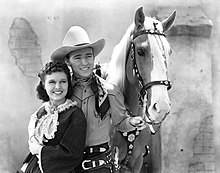
From his first film appearance in 1935, he worked steadily in Western films, including a large supporting role as a singing cowboy while still billed as "Leonard Slye" in a Gene Autry movie. In 1938, when Autry entered the United States Army Air Force, Slye was immediately rechristened "Roy Rogers". Slye's stage name was suggested by Republic Picture's staff after Will Rogers and the shortening of Leroy, and he was assigned the lead in Under Western Stars. Rogers became a matinee idol and American legend. A competitor for Gene Autry as the nation's favorite singing cowboy was suddenly born. In addition to his own movies, Rogers played a supporting role in the John Wayne classic Dark Command (1940). Rogers became a major box office attraction. Unlike other stars, the vast majority of Rogers' leading roles allowed him to play a character with his own name.

In the Motion Picture Herald Top Ten Money-Making Western Stars poll, Rogers was listed for 15 consecutive years from 1939 to 1954, holding first place from 1943 to 1954. He appeared in the similar Box Office poll from 1938 to 1955, holding first place from 1943 to 1952. (In the final three years of that poll he was second only to Randolph Scott.) Although these two polls are really an indication only of the popularity of series stars, Rogers also appeared in the Top Ten Money Makers Poll of all films in 1945 and 1946.
Rogers was an idol for many children through his films and television shows. Most of his postwar films were in Trucolor during an era when almost all other B westerns were black-and-white. Some of his movies would segue into animal adventures, in which Rogers's horse Trigger would go off on his own for a while, with the camera following him.
With money from not only Rogers' films but his own public appearances going to Republic Pictures, Rogers brought a clause into a 1940 contract with the studio where he would have the right to his likeness, voice and name for merchandising. There were Roy Rogers action figures, cowboy adventure novels, and playsets, as well as a comic strip, a long-lived Dell Comics comic book series (Roy Rogers Comics) written by Gaylord Du Bois, and a variety of marketing successes. Roy Rogers was second only to Walt Disney in the amount of items featuring his name.
The Sons of the Pioneers continued their popularity, and they have never stopped performing from the time Rogers started the group, replacing members as they retired or passed away (all original members are deceased). Although Rogers was no longer an active member, they often appeared as Rogers' backup group in films, radio, and television, and Rogers would occasionally appear with them in performances up until his death. In August 1950, Evans and Rogers had a daughter, Robin Elizabeth, who had Down Syndrome and died of complications with mumps shortly before her second birthday. Evans wrote about losing their daughter in her book Angel Unaware.
Rogers and Evans were also well known as advocates for adoption and as founders and operators of children's charities. They adopted several children. Both were outspoken Christians. In Apple Valley, California, where they made their home, numerous streets and highways as well as civic buildings have been named after them in recognition of their efforts on behalf of homeless and handicapped children. Rogers was an active Freemason and a Shriner, and was noted for his support of their charities.
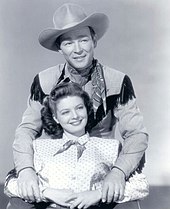
Rogers and Evans's famous theme song, "Happy Trails", was written by Evans; they sang it as a duet to sign off their television show. In the fall of 1962, the couple co-hosted a comedy-western-variety program, The Roy Rogers and Dale Evans Show, aired on ABC. It was cancelled after three months, losing in the ratings to The Jackie Gleason Show on CBS. He also made numerous cameo or guest appearances on other popular television shows, starring as himself or other cowboy-type characters, such as in an episode of Wonder Woman called "The Bushwackers". Rogers also owned a Hollywood production company which handled his own series. It also filmed other undertakings, including the 1955–1956 CBS western series Brave Eagle starring Keith Larsen as a young peaceful Cheyenne chief, Kim Winona as Morning Star, his romantic interest, and the Hopi Indian Anthony Numkena as Keena, Brave Eagle's foster son.
In 1968, Rogers licensed his name to the Marriott corporation, which converted its Hot Shoppes locations to Roy Rogers Restaurants, with which Rogers otherwise had no involvement.
Rogers owned a Thoroughbred racehorse named Triggairo, who won 13 career races including the 1975 El Encino Stakes at Santa Anita Park.
Personal life
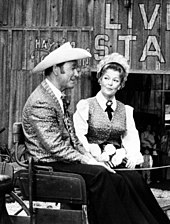
In 1932 a palomino colt foaled in California was named "Golden Cloud"; when Len acquired him, he renamed him "Trigger". Len then went on tour with the "O-Bar-O Cowboys" and in June 1933 met Grace Arline Wilkins at a Roswell, New Mexico radio station. She traded Len a lemon pie for his singing "Swiss Yodel" over the air. They were married in Roswell, New Mexico on June 11, 1936 after having corresponded since their first meeting. In 1941, the couple adopted a girl, Cheryl Darlene. Two years later, Arline bore daughter Linda Lou. She bore Roy, Jr. ("Dusty") in 1946, but died of complications from the birth a few days later, on November 3.
Rogers had met Dale Evans in 1944 when they were cast in a film together. They fell in love soon after Arline's death and Rogers proposed to her during a rodeo at Chicago Stadium. They married on New Year's Eve in 1947 at the Flying L Ranch in Davis, Oklahoma, where they had filmed Home in Oklahoma a few months earlier. They stayed married until Rogers's death in 1998.
Rogers was a Freemason and was a member of Hollywood (CA) Lodge #355, the Scottish Rite Valley of Los Angeles, and Al Malaikah Shrine Temple.
Death
When Rogers died of congestive heart failure on July 6, 1998, he was residing in Apple Valley, California. He was buried at Sunset Hills Memorial Park in Apple Valley, as was his wife, Dale Evans, three years later.
Honors and awards

On February 8, 1960, Roy Rogers was honored with three stars on Hollywood Walk of Fame: for Motion Pictures at 1752 Vine Street, for Television at 1620 Vine Street, and for Radio at 1733 Vine Street. In 1983 he was awarded the Golden Boot Award, and in 1996 he received the Golden Boot Founder's Award.
In 1976, Rogers and Evans were inducted into the Western Performers Hall of Fame at the National Cowboy & Western Heritage Museum in Oklahoma City, Oklahoma, and in 1995 he was inducted again as a founding member of the Sons of the Pioneers.
Rogers was also twice elected to the Country Music Hall of Fame, first as a member of the Sons of the Pioneers in 1980, and again as a soloist in 1988. To this day, he remains the only person elected to the Country Music Hall of Fame twice. In 2001, a Golden Palm Star on the Palm Springs, California, Walk of Stars was dedicated to him and Dale Evans.
Rogers' cultural influence is reflected in numerous songs, including "If I Had a Boat" by Lyle Lovett, "Roy Rogers" by Elton John on his 1973 album Goodbye Yellow Brick Road, and "Should've Been a Cowboy" by Toby Keith. Rogers himself makes an appearance in the music video for the song "Heroes and Friends" by Randy Travis. Rogers is referenced in numerous films, including Die Hard (1988) in which the Bruce Willis character John McClane used the pseudonym "Roy" and remarks, "I was always kinda partial to Roy Rogers actually." In the television series American Dad, the character Roger uses "Roy Rogers" as a pseudonym in the episode "Roy Rogers McFreely".
Filmography
- Slightly Static (1935) (uncredited)
- The Old Homestead (1935) (as Len Slye)
- Way Up Thar (1935) (as Len Slye)
- Gallant Defender (1935) (uncredited)
- The Mysterious Avenger (1936) (as Len Slye)
- Song of the Saddle (1936) (uncredited)
- Rhythm on the Range (1936) (uncredited)
- California Mail (1936) (uncredited)
- The Big Show (1936) (uncredited)
- The Old Corral (1936) (uncredited)
- The Old Wyoming Trail (1937) (uncredited)
- Wild Horse Rodeo (1937) (as Dick Weston)
- The Old Barn Dance (1938) (as Dick Weston)
- Under Western Stars (1938)
- Billy the Kid Returns (1938)
- A Feud There Was (1938) (uncredited)
- Come On, Rangers (1938)
- Shine On, Harvest Moon (1938)
- Rough Riders' Round-up (1939)
- Southward Ho (1939)
- Frontier Pony Express (1939)
- In Old Caliente (1939)
- Wall Street Cowboy (1939)
- The Arizona Kid (1939)
- Jeepers Creepers (1939)
- Saga of Death Valley (1939)
- Days of Jesse James (1939)
- Dark Command (1940)
- Young Buffalo Bill (1940)
- The Carson City Kid (1940)
- The Ranger and the Lady (1940)
- Colorado (1940)
- Young Bill Hickok (1940)
- The Border Legion (1940)
- Robin Hood of the Pecos (1941)
- Arkansas Judge (1941)
- In Old Cheyenne (1941)
- Sheriff of Tombstone (1941)
- Nevada City (1941)
- Bad Man of Deadwood (1941)
- Jesse James at Bay (1941)
- Red River Valley (1941)
- Man from Cheyenne (1942)
- South of Santa Fe (1942)
- Sunset on the Desert (1942)
- Romance on the Range (1942)
- Sons of the Pioneers (1942)
- Sunset Serenade (1942)
- Heart of the Golden West (1942)
- Ridin' Down the Canyon (1942)
- Idaho (1943)
- King of the Cowboys (1943)
- Song of Texas (1943)
- Silver Spurs (1943)
- Hands Across the Border (1944)
- Cowboy and the Senorita (1944)
- The Yellow Rose of Texas (1944)
- Song of Nevada (1944)
- San Fernando Valley (1944)
- Lights of Old Santa Fe (1944)
- Hollywood Canteen (1944)
- Utah (1945)
- Bells of Rosarita (1945)
- The Man from Oklahoma (1945)
- Along the Navajo Trail (1945)
- Sunset in El Dorado (1945)
- Don't Fence Me In (1945)
- Song of Arizona (1946)
- Rainbow Over Texas (1946)
- My Pal Trigger (1946)
- Under Nevada Skies (1946)
- Roll on Texas Moon (1946)
- Home in Oklahoma (1946)
- Out California Way (1946)
- Heldorado (1946)
- Apache Rose (1947)
- Bells of San Angelo (1947)
- Springtime in the Sierras (1947)
- On the Old Spanish Trail (1947)
- Melody Time (1948)
- The Gay Ranchero (1948)
- Under California Stars (1948)
- Eyes of Texas (1948)
- Night Time in Nevada (1948)
- Grand Canyon Trail (1948)
- The Far Frontier (1948)
- Susanna Pass (1949)
- Down Dakota Way (1949)
- The Golden Stallion (1949)
- Bells of Coronado (1950)
- Twilight in the Sierras (1950)
- Trigger, Jr. (1950)
- Sunset in the West (1950)
- North of the Great Divide (1950)
- Trail of Robin Hood (1950)
- Spoilers of the Plains (1951)
- Heart of the Rockies (1951)
- In Old Amarillo (1951)
- South of Caliente (1951)
- Pals of the Golden West (1951)
- Son of Paleface (1952)
- Alias Jesse James (1959) (uncredited)
- Mackintosh and T.J. (1975)
- The Muppet Show (1979)
- The Fall Guy (1983 and 1984)
Box office ranking
For a number of years exhibitors voted Rogers among the most popular stars in the country:
- 1942 – 2nd most popular Western star (followed Gene Autry)
- 1943 – most popular Western star
- 1944 – 24th most popular star in the U.S., and most popular Western star
- 1945 – most popular Western star, 11th most popular star
- 1946 – 10th most popular star in the US; most popular Western star
- 1947 – most popular Western star
- 1948 – most popular Western star
- 1949 – most popular Western star
- 1950 – 19th (US), most popular Western sar
- 1951 – most popular Western star
- 1952 – most popular Western star (for the 10th year in a row)
Discography
Charted albums
| Year | Album | Chart Positions | Label | |
|---|---|---|---|---|
| US Country | US | |||
| 1970 | The Country Side of Roy Rogers | 40 | — | Capitol |
| 1971 | A Man from Duck Run | 34 | — | |
| 1975 | Happy Trails to You | 35 | — | 20th Century |
| 1991 | Tribute | 17 | 113 | RCA |
Charted singles
| Year | Single | Chart Positions | Album | |
|---|---|---|---|---|
| US Country | CAN Country | |||
| 1946 | "A Little White Cross on the Hill" | 7 | — | Singles only |
| 1947 | "My Chickashay Gal" | 4 | — | |
| 1948 | "Blue Shadows on the Trail" (Roy Rogers and the Sons of the Pioneers) |
6 | — | |
| "(There'll Never Be Another) Pecos Bill" (Roy Rogers and the Sons of the Pioneers) |
13 | — | ||
| 1950 | "Stampede" | 8 | — | |
| 1970 | "Money Can't Buy Love" | 35 | — | The Country Side of Roy Rogers |
| 1971 | "Lovenworth" | 12 | 33 | A Man from Duck Run |
| "Happy Anniversary" | 47 | — | ||
| 1972 | "These Are the Good Old Days" | 73 | — | Single only |
| 1974 | "Hoppy, Gene and Me" | 15 | 12 | Happy Trails to You |
| 1980 | "Ride Concrete Cowboy, Ride" (Roy Rogers and the Sons of the Pioneers) |
80 | — | Smokey & the Bandit II (soundtrack) |
| 1991 | "Hold on Partner" (w/ Clint Black) | 42 | 48 | Tribute |
- "Hoppy, Gene and Me" also peaked at number 65 on the Billboard Hot 100 and number 38 on the RPM Adult Contemporary Tracks chart in Canada.
Music videos
| Year | Video | Director |
|---|---|---|
| 1991 | "Hold on Partner" (with Clint Black) | Jack Cole |
Popular songs recorded by Rogers
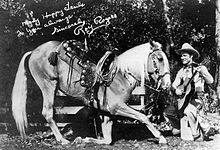
- "Don't Fence Me In"
- "Hold That Critter Down"
- "Little White Cross On The Hill"
- "One More Ride"
- "Ride Ranger Ride"
- "That Pioneer Mother Of Mine"
- "Tumbling Tumbleweeds"
- "Way Out There" (singing and yodeling)
- "Why, Oh Why, Did I Ever Leave Wyoming?"
- "Hold On Partner" (duet with Clint Black)
See also
- Roy Rogers Restaurants
- Roy Rogers cocktail
- Earl W. Bascom, cowboy artist who worked with Roy Rogers
References
- Notes
- ^ Zwisohn, Laurence. "Happy Trails: The Life of Roy Rogers". Roy Rogers. Retrieved April 29, 2014.
- Green, p. 74.
- ^ "Sons of the Pioneers". Country Music Television. Retrieved April 29, 2014.
- Green, p. 75.
- "Sons of the Pioneers". Encyclopedia.com. Retrieved August 27, 2011.
{{cite web}}: Italic or bold markup not allowed in:|publisher=(help) - http://www.imdb.com/name/nm0001678/
- Hardy, Phil (1984). The Encyclopedia of Western Movies. Minneapolis: Woodbury Press. ISBN 978-0-8300-0405-8.
- "Motion Picture Herald and Boxoffice Polls". B-westerns.com. Retrieved October 31, 2011.
- "Top Ten Money Making Stars". Quigleypublishing.com. Retrieved 2013-08-09.
- Phillips, 38
- Enss/Kazanjian, 132
- "Wonder Woman : Pilot: The New Original Wonder Woman". Thewb.com. Retrieved October 31, 2011.
- "Triggairo Horse Pedigree". Pedigree Online Thoroughbred Database. Retrieved October 31, 2011.
- ^ Phillips, 13-15
- "Famous Masons". MWGLNY. January 2014.
- Brooks, Patricia; Brooks, Jonathan (2006). "Chapter 8: East L.A. and the Desert". Laid to Rest in California: a guide to the cemeteries and grave sites of the rich and famous. Guilford, Connecticut: Globe Pequot Press. pp. 235–7. ISBN 978-0762741014. OCLC 70284362.
- Roy Rogers at Find a Grave
- "Hollywood Star Walk: Roy Rogers". Los Angeles Times. July 7, 1998. Retrieved April 29, 2014.
- ^ "Legacy". Golden Boot Awards. Retrieved April 29, 2014.
- "Great Wwstern Performers". National Cowboy & Western Heritage Museum. Retrieved April 29, 2014.
- "Roy Rogers". Country Music Hall of Fame. Retrieved April 29, 2014.
- "Palm Springs Walk of Stars" (PDF). Palm Springs Walk of Stars. Retrieved August 9, 2013.
- "The Screen's First Money-Spinneks For 1942". The Argus. Melbourne: National Library of Australia. 27 February 1943. p. 6 Supplement: The Argus Week-end Magazine. Retrieved 5 October 2014.
- "Bing Crosby America's Screen Favourite". The Argus. Melbourne: National Library of Australia. 24 March 1945. p. 8 Supplement: The Argus Week-end Magazine. Retrieved 5 October 2014.
- "Film Cable From Hollywood". The Sunday Times. Perth: National Library of Australia. 2 December 1945. p. 5 Section: The Sunday Times COMICS. Retrieved 5 October 2014.
- "Box Office Stars". The News. Adelaide: National Library of Australia. 28 December 1945. p. 1. Retrieved 5 October 2014.
- "THE BOX OFFICE DRAW". Goulburn Evening Post (NSW : 1940 – 1954). NSW: National Library of Australia. 31 December 1948. p. 3 Edition: Daily and Evening. Retrieved 5 October 2014.
- "Filmdom Ranks Its Money-Spinning Stars Best At Box-Office". The Sydney Morning Herald. National Library of Australia. 30 March 1950. p. 12. Retrieved 5 October 2014.
- "COMEDIANS TOP FILMS POLL". The Advocate. Burnie, Tas.: National Library of Australia. 27 December 1952. p. 2. Retrieved 5 October 2014.
- Whitburn, Joel (2011). Top Pop Singles 1955–2010. Record Research, Inc. p. 762. ISBN 0-89820-188-8.
- Bibliography
- Enss, Chris; Kazanjian, Howard (2005). The Cowboy and the Senorita. Guilford, Connecticut: Globe Pequot Press. ISBN 978-0762738304.
- Green, Douglas B. (2002). Singing in the Saddle: The History of the Singing Cowboy. Nashville: Vanderbilt University Press. ISBN 978-0826514127.
- Kazanjian, Howard (2005). Happy Trails: A Pictorial Celebration ... Guilford, Connecticut: Globe Pequot Press. ISBN 978-0762730896.
- Pando, Leo (2007). An Illustrated History of Trigger, The Lives and Legend of Roy Rogers' Palomino. McFarland Publishing. ISBN 978-0-7864-6111-0.
- Phillips, Robert W. (1995). Roy Rogers: A Biography. Jefferson, North Carolina: McFarland. ISBN 978-0899509372.
- Rogers, Roy; Evans, Dale (1994). Happy Trails: Our Life Story. New York: Simon & Schuster. ISBN 978-0671897147.
- Rogers, Roy; Evans, Dale; Stowers, Carlton (1979). Happy Trails: The Story of Roy Rogers and Dale Evans. Waco: Word Books. ISBN 978-0849900860.
- Rogers, Roy; Morris, Georgia (1994). Roy Rogers: King of the Cowboys. New York: Collins Publishers. ISBN 978-0002553346.
- Zwisohn, Laurence (1998). Paul Kingsbury (ed.). The Encyclopedia of Country Music. New York: Oxford University Press. pp. 456–57. ISBN 978-0195116717.
External links
- Official website
- Roy Rogers at IMDb
- Roy Rogers comic books
- Profile at Turner Classic Movies
- Roy Rogers at the Internet Broadway Database
- Country Music Hall of Fame
- Public domain Roy Rogers media at Internet Archive
- "Roy & Dale 100th Anniversary"
- 1911 births
- 1998 deaths
- 20th-century American male actors
- American country singers
- American country singer-songwriters
- American male film actors
- American male singers
- American male television actors
- Western (genre) television actors
- American Presbyterians
- American racehorse owners and breeders
- Bell Records artists
- California Republicans
- Capitol Records artists
- Cardiovascular disease deaths in California
- Country Music Hall of Fame inductees
- Country musicians from Ohio
- Deaths from congestive heart failure
- Decca Records artists
- Male actors from Cincinnati, Ohio
- Male Western (genre) film actors
- Musicians from Cincinnati, Ohio
- Ohio Republicans
- People from Portsmouth, Ohio
- RCA Victor artists
- Singers from Ohio
- Singing cowboys
- Vocalion Records artists
- Yodelers
- 20th-century American singers